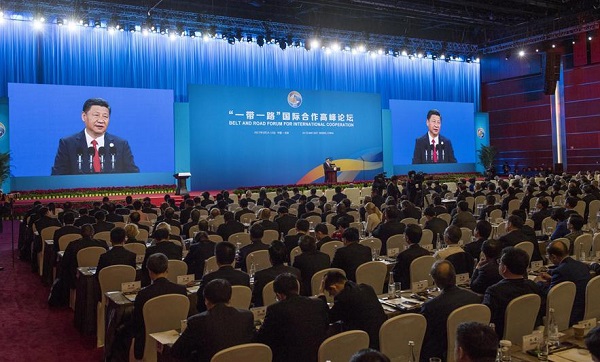

Follow us on:  
|


Chinese President Xi Jinping delivers a keynote speech at the opening ceremony of the Belt and Road Forum for International Cooperation in Beijing, capital of China, May 14, 2017 [Xinhua]
This includes an additional 100 billion yuan (about $14.5 billion) to the Silk Road Fund, Chinese President Xi Jinping announced at a summit in Beijing on Sunday.
China had earlier set up a state-financed $40 billion Silk Road Fund.
On Sunday, Xi hosted leaders and heads of state from 110 participant countries at the two-day Belt and Road Forum for International Cooperation.
China will provide assistance worth 60 billion yuan ($8.7 billion) to developing countries and international organizations participating in the “Belt and Road” drive to launch more projects to improve people’s well-being, the Chinese President announced.
Xi reiterated his vigorous defense of free trade at the summit in Beijing, in continuation of his speech at the World Economic Forum in Davos earlier in January.
“We should jointly create an environment that will facilitate opening up and development, establish a fair, equitable and transparent system of international trade and investment rules and boost the orderly flow of production factors, efficient resources allocation and full market integration,” he said on Sunday.
“We should build an open platform of cooperation and uphold and grow an open world economy,” Xi added.
In attendance at the Chinese power summit in Beijing were: Russian President Vladimir Putin, UN Secretary General António Guterres, President of the World Bank Jim Yong Kim, and Chief of the IMF Christine Lagarde.
Xi pledged 250 billion yuan in loans from China Development Bank, 130 billion yuan in loans from Export-Import Bank of China, 2 billion yuan in emergency food aid, $1 billion to a South–South Cooperation fund.
China’s One Belt, One Road initiative aims to create a modern Silk Road Economic Belt and a 21st Century Maritime Silk Road to boost trade and extend its global influence.
The ancient Silk Road connected China and Europe from around 100 B.C.
The 6,000-km road linked ancient Chinese, Indian, Babylonian, Arabic, Greek and Roman civilizations.
A map unveiled by state agency Xinhua shows the Chinese plans for the Silk Road run through Central China to the northern Xinjiang from where it travels through Central Asia entering Kazakhstan and onto Iraq, Iran, Syria and then Istanbul in Turkey from where it runs across Europe cutting across Germany, Netherlands and Italy.
The maritime Silk Road begins in China’s Fujian and ends at Venice, Italy.
The network would include building railways, highways, oil and gas pipelines, power grids, Internet networks, maritime and other infrastructure links.
In 2014, China announced a $40 billion Silk Road Fund to strengthen connectivity in the Asia-Pacific region.
TBP